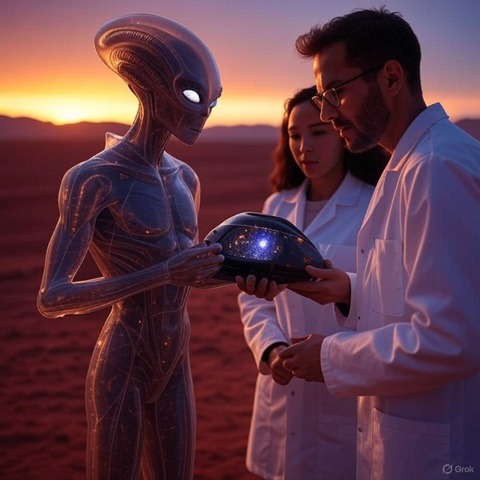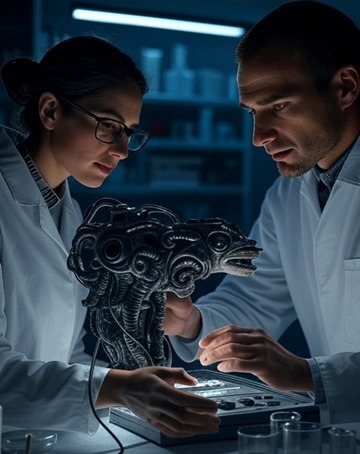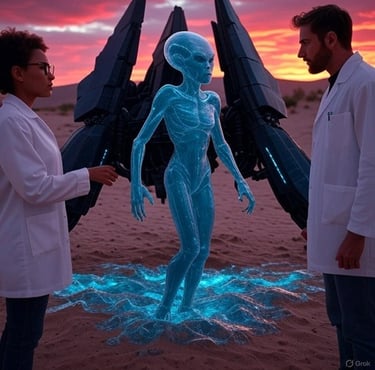AI Written Science Fiction That Shivers The Spine
Aliens Landed on Earth—and What They Revealed Will Shock You!
First contact with aliens unveils secrets that could doom or save humanity
The sky over New Mexico bled crimson on the evening of July 7, 2047, when the first alien craft touched down. It wasn’t a saucer or a sleek warship like the movies promised, but a jagged, obsidian structure, like a shard of volcanic glass the size of a football stadium. It landed silently in the Chihuahuan Desert, kicking up no dust, leaving no scorch marks. The world held its breath as satellites beamed the image to every screen on the planet. Humanity’s first contact had begun.
Dr. Elena Vasquez, a linguist and cryptographer, was summoned to the site within hours. She’d spent her career decoding ancient languages and machine learning algorithms, but nothing prepared her for this. The U.S. military had cordoned off a 50-mile radius around the craft, dubbed “Obsidian One” by the media. Elena’s team, a mix of scientists, engineers, and diplomats, was tasked with one goal: communicate. The world’s governments, uneasy allies under the United Nations’ hastily formed First Contact Coalition (FCC), demanded answers. Were the aliens hostile? Benevolent? Indifferent?
Elena stood before Obsidian One, its surface absorbing light like a black hole. No doors, no windows, no seams. Just an impenetrable monolith. Her tablet buzzed with data from the sensors arrayed around the craft—electromagnetic spikes, faint vibrations, and something else, a rhythmic pulse that felt almost biological. “It’s alive,” she whispered to her colleague, Dr. Raj Patel, a biophysicist with a knack for seeing patterns where others saw chaos.
“Alive?” Raj raised an eyebrow, his dark eyes glinting under the floodlights. “Or just mimicking life to mess with us?”
Before Elena could respond, a low hum vibrated through the desert, rattling her bones. The craft’s surface rippled, and a section dissolved into a shimmering portal. From it stepped a figure—humanoid, but wrong. Its skin was translucent, revealing a network of glowing filaments beneath, pulsing like fiber optics. Its eyes, too large and too deep, locked onto Elena. She froze, her mind racing to catalog every detail: no mouth, no nose, just those eyes and a faint hum emanating from its core.
The creature raised a hand, and a holographic interface materialized in the air, displaying symbols that danced like liquid light. Elena’s heart pounded. This was her moment. Years of studying dead languages, of wrestling meaning from chaos, had led to this. She stepped forward, her tablet already analyzing the symbols. They weren’t random—they followed a structure, a syntax. “It’s a language,” she said, her voice steady despite the adrenaline. “They’re trying to talk.”


The FCC’s lead diplomat, Ambassador Clara Henshaw, a sharp-tongued woman with decades of experience navigating global crises, pushed past the soldiers. “Dr. Vasquez, what do they want?”
“I don’t know yet,” Elena admitted, her fingers flying over her tablet. “But they’re not shooting, so that’s a start.”
Over the next week, Elena and Raj worked tirelessly to decipher the alien language, which they called Lumora, after the glowing filaments in the creature’s body. The alien, whom they named “Emissary” for lack of a better term, was patient, almost eerily so. It responded to their attempts with subtle shifts in its holographic displays, guiding them toward understanding. By day ten, Elena had cracked the basic syntax. The Lumora language was a hybrid of mathematics and emotion, conveying concepts through layered frequencies rather than linear words. It was beautiful, alien, and terrifying.
The Emissary’s first clear message came on day twelve: “We are the Kaelith. We come to share.” The words, translated through Elena’s software, sent a ripple of excitement through the FCC. Share what? Knowledge? Technology? Peace? The world’s leaders, watching via secure feeds, demanded more. But Elena sensed something off. The Kaelith’s messages were too precise, too tailored to human expectations. Why would an alien species, light-years beyond humanity’s tech, bother with such careful diplomacy?
Raj shared her unease. Late one night, as they pored over data in their makeshift lab, he leaned close. “Elena, think about it. They landed in the middle of nowhere, not D.C. or Beijing. Why? And why just one ship? This feels like a performance.”
Elena frowned, her eyes scanning the latest Lumora translations. “You think they’re hiding something?”
“I think they’re playing us,” Raj said. “And we’re eating it up.”
The breakthrough came on day fifteen. The Emissary offered a gift: a device the size of a grapefruit, its surface a lattice of glowing crystals. The Kaelith claimed it was a “symbiotic core,” capable of solving Earth’s energy crisis. Plug it into any power grid, they said, and it would generate limitless clean energy. The FCC was ecstatic. World leaders hailed it as a new era. Protests erupted globally—some worshipped the Kaelith as gods, others demanded they leave. Elena, though, couldn’t shake her doubts. The core’s design was too simple, too perfect. It felt like bait.
She and Raj ran tests in secret, bypassing FCC protocols. The core emitted no radiation, no heat, just a steady hum. But under a quantum scanner, Raj found something chilling: the core was rewriting itself, its internal structure shifting like a living organism. “This isn’t a power source,” he whispered, his voice tight. “It’s a seed. It’s growing.”
Before they could report their findings, the Emissary requested a meeting with the FCC’s top brass. Elena and Raj were sidelined, replaced by military engineers eager to integrate the core into global grids. Ambassador Henshaw, sensing their frustration, pulled Elena aside. “You’re too cautious,” she said. “The world needs this. Don’t ruin it with paranoia.”


But Elena wasn’t paranoid—she was right. That night, she hacked into the FCC’s secure servers, uncovering a hidden directive: the U.S. and China, unbeknownst to the rest of the coalition, had already begun replicating the core’s technology. They weren’t sharing it with the world—they were weaponizing it. The Kaelith’s “gift” was a Trojan horse, and humanity’s greed was opening the gates.
Elena confronted Henshaw, who admitted the truth with a cold smile. “The Kaelith don’t care about our squabbles,” she said. “They want partners, not equals. We’re securing our future.”
“You’re selling us out,” Elena snapped. “That core isn’t what you think.”
Henshaw’s eyes narrowed. “Prove it, or stay out of the way.”
Elena and Raj had no choice—they had to act. They stole the core from the FCC’s lab, rigging a decoy to buy time. In a hidden bunker, they dissected the device, confirming their worst fears: it was a control node, designed to link Earth’s infrastructure to a Kaelith network. Once activated, it would give the aliens remote access to every power grid, every weapon, every system. The Kaelith weren’t sharing—they were colonizing.
But the double-cross ran deeper. As Elena and Raj prepared to expose the truth, they were ambushed—not by the FCC, but by a faction within their own team. Dr. Mei Chen, a soft-spoken engineer who’d worked closely with them, revealed herself as a Kaelith operative. Her human facade melted away, exposing a translucent form identical to the Emissary’s. “You were close,” she said, her voice a harmonic hum. “But you’re too late.”
Mei had been planted years ago, manipulating humanity’s response from the start. The Kaelith had studied Earth for decades, seeding agents to ensure compliance. The core was just the final step. “We don’t conquer,” Mei said. “We integrate. Your species will thrive under our guidance.”
Raj lunged, tackling Mei as Elena grabbed the core. They fled into the desert, pursued by drones and Kaelith agents. In a desperate gamble, Elena uploaded a virus she’d written into the core, designed to disrupt its connection to the Kaelith network. The device pulsed wildly, its crystals fracturing. A shockwave knocked them flat as Obsidian One lit up, its hum rising to a deafening scream.
When Elena came to, the craft was gone. So was the core. Raj lay beside her, alive but dazed. The desert was silent, the sky clear. Had they won? Destroyed the Kaelith’s plan? Or had the aliens simply retreated, their agents still embedded among humanity?
Days later, the FCC declared the Kaelith a hoax, blaming the incident on a failed military experiment. The world, desperate for normalcy, bought the lie. But Elena and Raj knew better. They went underground, sharing their data with rogue scientists and hackers. The Kaelith were still out there, watching, waiting. And humanity’s leaders, complicit or clueless, were paving the way for their return.
As Elena stared at the stars one night, a new message flickered on her tablet, in Lumora: “We will share again.” Her blood ran cold. The game wasn’t over—it was just beginning.



Get in Touch
We’re here to help you enhance your life with AI.